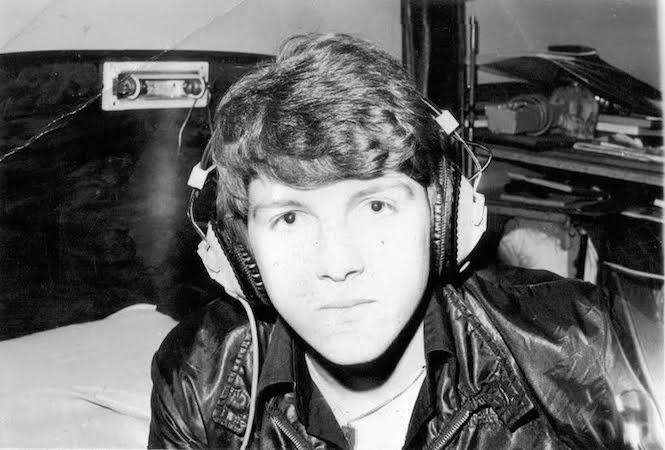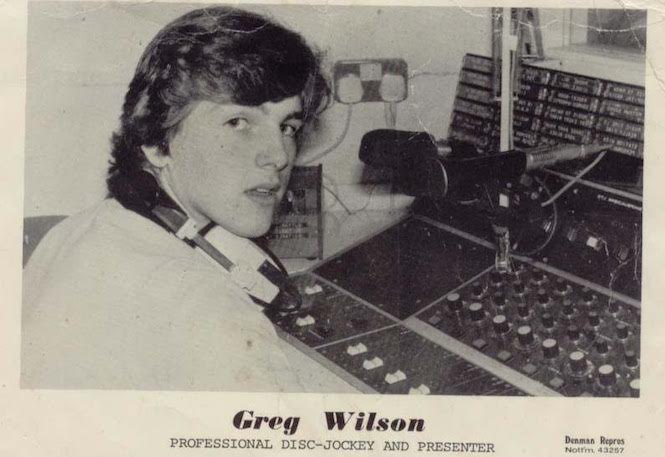Published on
December 3, 2015
Category
Features

One track on each side – the definitive A-side and the often surprising B-side – there’s a beautiful symmetry and simplicity to the 7″ vinyl record.
Greg Wilson, who celebrates 40 years since his first club date this weekend, started DJ’ing long before the dawn of 12″ – a time when 45s presided over the dancefloor. With the launch of new label Super Weird Substance, we invited Wilson to pay tribute to vinyl’s most portable format.
Words: Greg Wilson
My love affair with the 7” single began back in the ’60s when my older brother (by 10 years), and then my older sister (by 6 years), began bringing home what I referred to in the introduction to my blog as those circular pieces of magical plastic.
These, mainly soul, records would do no less than shape my life. When my brother, like many former Mods, began to embrace the psychedelic, progressive rock directions and switched to the more mature LP format, I was able to liberate all these precious 45s (as the Americans called them), mainly on the classic labels of the period – Tamla Motown, Stax and Atlantic.
When my sister moved away to join the Wrens I hit the 7” jackpot once again, with lots more Tamla tunes, but also a smattering of reggae on the Trojan and Pyramid labels. It was these singles that were at the foundation of my record collection.

A further source was via the jukebox we had in the pub my parents ran, and which we lived above. My Mum or Dad would often give me some change so I could play a few tunes. This was generally during the daytime when the pub was quiet and I could sit in the back room, sometimes with a friend, listening to the singles on there. I devoured a lot of music that neither my brother nor my sister owned in this way.
Every couple of weeks the ‘Jukebox Man’ would come to the pub to add a few new singles, whilst taking out some old ones, and I’d hang around hoping he’d let me have a couple of the ones he was removing. I’d often bug him for a particular record I wanted, sometimes having to wait a number of visits before he finally replaced the one I coveted.
These ex-jukebox singles were sold on to record shops cut price – an ex-jukebox record was easy to identify as the centre had been ‘dinked’ out, so you needed to use an adapter or, as we used to call it, a spider in order to play it. In the US they manufactured their singles without a centre, the vinyl 45 having been introduced by The Seeborn Corporation in 1950 as the ideal jukebox format to replace the shellac 78. When I began to buy records myself, I’d supplement my collection with ex-jukebox singles, picking up releases from the previous years relatively cheaply in this way.
The many mobile discos that came in and out of the building in which I lived, a pub called The Criterion, were another key source of discovery. Apart from the musical gems I heard in this way over the seven years I lived there, the DJs would sometimes leave their equipment and records overnight, collecting them the following day. This presented the opportunity for me to slip in in the morning, turn everything on, and play DJ.
The first record I actually went into a shop and bought with my own money wasn’t a great soul or classic reggae track, not even a hooky pop hit of the day, but a novelty record by the then popular British comedian Benny Hill who topped the chart with ‘Ernie (The Fastest Milkman In The West)’ (which, I subsequently learnt was also the first record bought by Bill Brewster, the co-author of the book Last Night A DJ Saved My Life). Hill’s often smutty sketches were born of the saucy seaside postcard mentality of post-war Britain, with its ‘Carry On’ films and nudge nudge wink wink.
This was in 1971 when I was eleven, the record, on EMI’s Columbia label, purchased from an electrical shop called Chester’s, up the road from where I lived on Victoria Road in New Brighton. Despite its huge commercial success it hadn’t been installed on the pub jukebox, perhaps my Mum or Dad didn’t like it, but its absence forced my hand and the record shops of Wallasey, Birkenhead and Liverpool would come to nourish my new-found passion for the black stuff.
Throughout the next four years I’d build up a pretty formidable singles collection, so that by the end of 1975, when I started to DJ in local clubs, I was well tooled up. I used to put all my singles into white card sleeves onto which I’d write both A and B side titles, the artist name, and the genre of music. I’d also add my name and phone number, as well as stickering the record label with my name so, if lost, whoever found them wouldn’t be in any doubt with regards to who it belonged to. Finally, top centre, I’d write the first letter of the artist’s name, for further quick reference. I’d carry my 7” singles in wooden soft drinks crates, which were so perfectly sized you’d have thought they’d been specifically designed for this function.
Many would regard the 7” as the ultimate format. You knew where you stood with it – what was on the A side was regarded as definitive (albeit sometimes truncated from a longer album version), so there were no concerns about it being the wrong mix, and it had a B side surprise. Sometimes the B side was the one – many future classics were once deemed only good enough to appear on the flip. The idea of two tracks, one on each side, is what I grew up with, and this had a perfect symmetry.
The advent of the 12” single, which was first made commercially available in 1976, relegated the 7” to a bit part, at least where DJs were concerned – the additional length available, plus the extra volume possible, meant the 12” would soon become the essential DJ format.
I was able to re-ignite my love for the 7” by launching the Random Influences series in February 2010 to mark my 50th birthday year. This was a celebratory selection of 7” singles from my formative years, covering the ’60s through to the mid-’70s, when I started out as a fresh-faced 15 year old club DJ – these records embodying the soundtrack of my youth. With each episode running for 2 hours, the 12 individual monthly parts combine to add up to full day’s worth of music. The entire series can be streamed via Mixcloud.
In April 2012 I was invited to play at Electrik in Manchester (the bar run by the crew who were behind the influential Electric Chair club night). It was a gig with a difference, the DJ only having a single turntable to play their musical selections from. I took the opportunity to dig out forty odd 45s, just enough to fill an old 7” carrying case, thirty-one of which I got to play during my two hour slot.
These were all records I’d bought during the period 1972-1976, leading up to the dawn of the 12” format, and acting as a document to dance music in the proto-disco era, as well as a fitting tribute to what was undoubtedly the most important artefact of my youth. Have a listen here.
Read next: The evolution of physical music formats – an interactive timeline









